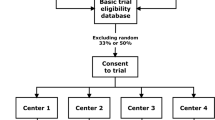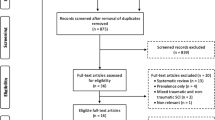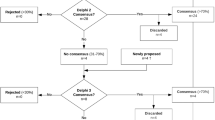Abstract
Study design:
A longitudinal, prospective, self-controlled cohort study.
Objectives:
To determine (1) the preliminary benefits of using eye-tracking computer systems (ETCSs) among inpatients with tetraplegia and (2) the feasibility of carrying out a well-powered randomized controlled trial.
Setting:
Specialist Spinal Cord Injuries Centre, United Kingdom; 6 months during 2013–2014.
Methods:
Individuals with tetraplegia who were admitted to the center and enrolled in this study were trained and allowed to use the ETCS (Tobii Eyegaze C15 System) twice a week for a duration of 10 weeks. Standardized training modules were developed and offered to all study participants. Study feasibility indicators as well as the Appraisals of Disability: Primary and Secondary Scale, Hospital Anxiety and Depression Scale and the Assistive Technology Device Predisposition Assessment questionnaire scores were taken before and after study enrollment.
Results:
A total of 31 inpatients with tetraplegia were screened. Although 14 patients (45%) met the study eligibility criteria, 6 patients (19%) consented to be enrolled in the study. Three participants did not complete the planned training schedule because of medical, technical and logistic reasons. Although half of the participants agreed that the ETCS under study was easy to use, no substantial improvements were seen in terms of psychological outcomes, appraisals of disability or independence.
Conclusions:
The conduct of a controlled trial evaluating the benefits of using ETCSs among newly injured patients with tetraplegia comes with considerable feasibility challenges. Until substantial technical improvements of ETCSs have been implemented, future research should initially focus on those individuals with tetraplegia who are living in the community and who have expressed a need to enhance their computer access and communication skills.
Similar content being viewed by others
Log in or create a free account to read this content
Gain free access to this article, as well as selected content from this journal and more on nature.com
or
References
Rudhe C, van Hedel HJ . Upper extremity function in persons with tetraplegia: relationships between strength, capacity, and the spinal cord independence measure. Neurorehabil Neural Repair 2009; 23: 413–421.
Toh E, Arima T, Mochida J, Omata M, Matsui S . Functional evaluation using motor scores after cervical spinal cord injuries. Spinal Cord 1998; 36: 491–496.
Schilero GJ, Spungen AM, Bauman WA, Radulovic M, Lesser M . Pulmonary function and spinal cord injury. Respir Physiol Neurobiol 2009; 166: 129–141.
Mortenson WB, Demers L, Fuhrer MJ, Jutai JW, Lenker J, DeRuyter F . How assistive technology use by individuals with disabilities impacts their caregivers: a systematic review of the research evidence. Am J Phys Med Rehabil 2012; 91: 984–998.
McKinley W, Tewksbury MA, Sitter P, Reed J, Floyd S . Assistive technology and computer adaptations for individuals with spinal cord injury. NeuroRehabilitation 2004; 19: 141–146.
Caligari M, Godi M, Guglielmetti S, Franchignoni F, Nardone A . Eye tracking communication devices in amyotrophic lateral sclerosis: impact on disability and quality of life. Amyotroph Lateral Scler Frontotemporal Degener 2013; 14: 546–552.
Doyle M, Phillips B . Trends in augmentative and alternative communication use by individuals with amyotrophic lateral sclerosis. Augment Altern Commun 2001; 17: 167–178.
Rigby P, Ryan SE, Campbell KA . Electronic aids to daily living and quality of life for persons with tetraplegia. Disabil Rehabil Assist Technol 2011; 6: 260–267.
Fager S, Beukelman DR, Fried-Oken M, Jakobs T, Baker J . Access interface strategies. Assist Technol 2011; 24: 25–33.
Trepagnier C . Tracking gaze of patients with visuospatial neglect. Top Stroke Rehabil 2002; 8: 79–88.
Spataro R, Ciriacono M, Manno C, La Bella V . The eye-tracking computer device for communication in amyotrophic lateral sclerosis. Acta Neurol Scand 2013; 130: 40–45.
Arain M, Campbell M, Cooper C, Lancaster G . What is a pilot or feasibility study? A review of current practice and editorial policy. BMC Med Res Methodol 2010; 10: 67.
Dean RE, Kennedy P . Measuring appraisals following acquired spinal cord injury: a preliminary psychometric analysis of the appraisals of disability. Rehabil Psychol 2009; 54: 222–231.
Zigmond AS, Snaith RP . The hospital anxiety and depression scale. Acta Psychiatr Scand 1983; 67: 361–370.
Woolrich RA, Kennedy P, Tasiemski T . A preliminary psychometric evaluation of the Hospital Anxiety and Depression Scale (HADS) in 963 people living with a spinal cord injury. Psychol Health Med 2006; 11: 80–90.
Scherer MJ . Assessing the benefits of using assistive technologies and other supports for thinking, remembering and learning. Disabil Rehabil 2005; 27: 731–739.
Spooren AI, Janssen-Potten YJ, Kerckhofs E, Seelen HA . Outcome of motor training programmes on arm and hand functioning in patients with cervical spinal cord injury according to different levels of the ICF: a systematic review. J Rehabil Med 2009; 41: 497–505.
Dost G, Dulgeroglu D, Yildirim A, Ozgirgin N . The effects of upper extremity progressive resistance and endurance exercises in patients with spinal cord injury. J Back Musculoskelet Rehabil 2014; 27: 419–426.
Kloosterman MG, Snoek GJ, Jannink MJ . Systematic review of the effects of exercise therapy on the upper extremity of patients with spinal-cord injury. Spinal Cord 2009; 47: 196–203.
Franke AC, Snoek GJ, de Groot S, Nene AV, Spooren AI, Post MW . Arm hand skilled performance in persons with a cervical spinal cord injury—long-term follow-up. Spinal Cord 2013; 51: 161–164.
Wessels R, Dijcks B, Soede M, Gelderblom GJ, De Witte L . Non-use of provided assistive technology devices, a literature overview. Technol Disabil 2003; 15: 231–238.
New PW, Jackson T . The costs and adverse events associated with hospitalization of patients with spinal cord injury in Victoria, Australia. Spine (Phila Pa 1976) 2010; 35: 796–802.
Haisma JA, van der Woude LH, Stam HJ, Bergen MP, Sluis TA, Post MW et al. Complications following spinal cord injury: occurrence and risk factors in a longitudinal study during and after inpatient rehabilitation. J Rehabil Med 2007; 39: 393–398.
Acknowledgements
Charitable donations were received from Aspire, M&G Charitable Donations Committee and Stoke Mandeville Spinal Research, previously known as Stoke Mandeville Spinal Foundation for financial support to purchase the devices under study and for the conduct of the study. Tobii Technology AB provided technical support throughout the study.
Author information
Authors and Affiliations
Corresponding author
Ethics declarations
Competing interests
The authors declare no conflict of interest.
Rights and permissions
About this article
Cite this article
van Middendorp, J., Watkins, F., Park, C. et al. Eye-tracking computer systems for inpatients with tetraplegia: findings from a feasibility study. Spinal Cord 53, 221–225 (2015). https://doi.org/10.1038/sc.2014.219
Received:
Revised:
Accepted:
Published:
Issue date:
DOI: https://doi.org/10.1038/sc.2014.219



